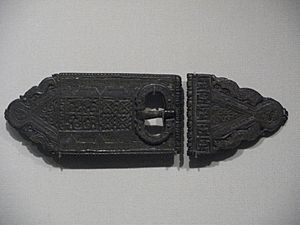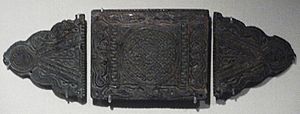Mucking (archaeological site) facts for kids
| Location | Mucking, Essex, England, United Kingdom |
|---|---|
| Coordinates | 51°29′38″N 00°25′48″E / 51.49389°N 0.43000°E |
| Type | Settlement and associated cemeteries |
| History | |
| Abandoned | During or after the 8th century |
| Periods | Roman and Anglo-Saxon |
| Site notes | |
| Excavation dates | 1965–1978 |
| Archaeologists | Margaret Jones and Tom Jones |
Mucking is an amazing archaeological site in Essex, England. It's a place where archaeologists found ancient remains from many different time periods. These include things from the Stone Age (Neolithic), Bronze Age, and even the Middle Ages. What's really special about Mucking are the discoveries from the Bronze Age and the Anglo-Saxons.
Huge archaeological digs happened at Mucking between 1965 and 1978. These digs were led by an archaeologist named Margaret Ursula Jones. The site covered a massive area, about 18 hectares (44 acres). At the time, it was the biggest archaeological dig in Europe. It's still the largest ever in the British Isles. The digging had to happen all year round. This was because a gravel company was quickly digging up the land. Archaeologists had to work fast to save the historical finds. They found an "astonishing" amount of ancient objects.
Contents
Finding the Mucking Site
The Mucking site is on a gravel terrace, about 100 feet (30 meters) above the River Thames. It's near the north bank of the river. Other Anglo-Saxon settlements were also found nearby.
The site was first discovered from pictures taken from the air. These pictures showed "cropmarks" and "soil marks." These are patterns in fields that show where old buildings or ditches used to be. The earliest photos were taken by the German air force (Luftwaffe) in 1943. But these photos weren't easily available to archaeologists.
The importance of the site became clear after new photos were taken. Dr. J.K. St. Joseph from Cambridge University took these pictures in 1959. A local farmer even joked that these crop marks were his "best crop." After the photos were published, people realized the site was in danger. A company was digging up gravel there. So, they worked to protect the site under an old law called the Ancient Monuments Act.
Before the big dig, a small team had already explored the area. They were from the Thurrock Local History Society. They found ancient objects just by walking across the fields. In late 1965, Margaret Jones was asked to do a quick test dig. The site was being slowly destroyed by the gravel company.
Margaret Jones's Big Dig (1965–1978)
After the test dig, Margaret Jones was put in charge of the full excavation. She was joined by her husband, Tom. In 1965, after the crops were harvested, they started their huge project. This dig would last for 14 years on the Mucking hilltop.
This excavation was special because it continued all through the winter. Most archaeological digs only happen in the summer. They had to keep digging to stay ahead of the gravel company. Sometimes, they even had to use a blow torch to melt frozen ground. This helped them dig up finds in time.
Many younger archaeologists and volunteers helped the Joneses. Over 3,000 students from many countries came to help. In warmer months, volunteers lived in tents. In winter, they stayed in old caravans and sheds. Margaret Jones managed the camp, food, and welfare of the volunteers. She sometimes said it felt more like a holiday camp than an archaeological dig. Towards the end of the dig, local unemployed people also helped. This was part of a government job creation program. Without their help, the excavation might not have finished.
Margaret Jones passed away in 2001. An article about her said that "to have dug with Margaret Jones at Mucking remains a badge of honour." This shows how respected she was. She left money in her will to support future research related to the Mucking digs.
Studying the Finds and Publishing Results
After the digging stopped, the team started studying all the finds. This "post-excavation" work happened from 1978 to 1985. This part of the project cost much more than the actual digging.
Studying the finds was difficult because there were so many. Also, the rules for what an archaeological report should include were changing. It wasn't enough to just tell a story about the dig. Now, reports needed to provide all the raw data. This way, other experts could study the finds and come up with their own ideas later.
Some people criticized the Mucking dig. They said it was "excavation without publication." This meant they dug up a lot but didn't publish the results fast enough. But Margaret Jones argued that saving the finds from the gravel company was the most important thing. She didn't want to waste time writing reports while the site was being destroyed.
Experts now agree that small test digs would not have shown the full picture. For example, they wouldn't have known that Mucking was one large settlement that moved over time. By 2009, three books about the excavation results were published. More reports on the Roman and pre-Roman periods were published later.
Discoveries at Mucking
The Mucking excavation uncovered more than 44,000 archaeological features. These included single graves and pits from the Stone Age (Neolithic period). They also found a hill fort from the Bronze Age. Over 100 Iron Age round houses were discovered. There was also a cemetery from the Roman-British period. The digs also showed signs of an important Roman-British building. Margaret Jones believed it was a Roman villa.
The Anglo-Saxon Settlement
The Roman-British people left the Mucking site in the 4th century. There was a gap before the Anglo-Saxons moved in during the early 5th century. This was one of the earliest Anglo-Saxon settlements in England. The Anglo-Saxon village slowly moved north over 200 years. Around the 8th century, the settlement was either left empty or moved outside the excavated area. The land where the Anglo-Saxons lived later became part of a field system used in the Saxon-Norman period.
Archaeologists found over 200 Anglo-Saxon "sunken featured buildings." These were small huts with floors dug into the ground. They also found nearly a dozen large timber buildings. These bigger halls were up to 50 feet (15 meters) long and 25 feet (7.6 meters) wide. They had entrances in the middle of their longer sides. There was also some evidence of fenced areas, which might have been for animals.
The Anglo-Saxon Cemeteries
More than 800 burials were found in the Anglo-Saxon cemeteries. These graves date from the early 5th to the 7th century. Two cemeteries were dug up. One of them had already been partly destroyed by gravel digging.
Cemetery II, which was mostly undamaged, had graves with 125 brooches. These brooches helped experts understand how Anglo-Saxons dressed. The cemeteries were not used after the mid-7th century. However, the settlement continued into the 8th century. Later burials might have happened at a Christian cemetery nearby.
Amazing Finds
Besides the brooches, other finds included Anglo-Saxon pottery from the 5th century. They also found late Roman military belt fittings. These were in a style called "Quoit Brooch Style." The landowners gave more than 5,000 items to the British Museum. Some of the original finds are on display at the British Museum. Others are kept in storage. Some copies of the finds are in the Thurrock Museum.
Why Mucking is Important
While finds from other periods are interesting, Mucking is most important as an Anglo-Saxon site. Places like Sutton Hoo showed us about kings and princes. But Mucking gave us a lot of information about how everyday people lived and worked. It was the first time a dig covered both an Anglo-Saxon village and its nearby cemetery.
The discoveries from Mucking have been used a lot in archaeological discussions. For example, before the dig was even finished, pottery from Mucking was used in a famous book about Anglo-Saxon England. Many other experts have used the Mucking results.
Some experts used Mucking to suggest that Anglo-Saxon settlements moved in the 8th century. They moved from lighter soils to heavier, more productive soils. Others have used Mucking to discuss how many Anglo-Saxons came to England after the Roman period. Some think Anglo-Saxons were forced to settle on poor land. Others believe the site was chosen by London authorities. They thought it could give early warning of enemy ships sailing up the river. The discovery of a "Roman style" military buckle in an Anglo-Saxon grave at Mucking also suggests a link between the Roman and Anglo-Saxon times.





